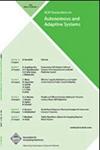现场自适应测试
IF 2.2
4区 计算机科学
Q3 COMPUTER SCIENCE, ARTIFICIAL INTELLIGENCE
引用次数: 0
摘要
我们被越来越多的系统所包围,这些系统将我们与数字世界连接起来,通过支持我们的工作、休闲、家庭活动、健康等,为我们的生活提供便利。这些系统受到两种力的压迫。一方面,由于不确定性和不可控性,它们在越来越具有挑战性的环境中运行。另一方面,它们需要不断发展,通常以连续的方式,以满足不断变化的需求,提供新的功能,或者修复出现的故障。使情况更加复杂的是,这些系统很少单独工作,往往需要与其他系统以及人类合作。所有这些方面都需要在操作过程中进行验证,如现场测试所提供的方法。在本文中,我们观察到,即使是基于现场的测试方法也应该随着时间的推移而改变,以遵循和适应协作系统或环境或用户行为的变化和演变。我们为这种新的测试类别提供了一个分类法,我们称之为现场自适应测试(SATF),以及SATF方法的参考体系结构。为了实现这一目标,我们调查了文献,并通过问卷调查和访谈收集了该领域专家的反馈和贡献。本文章由计算机程序翻译,如有差异,请以英文原文为准。
Self-Adaptive Testing in the Field
We are increasingly surrounded by systems connecting us with the digital world and facilitating our life by supporting our work, leisure, activities at home, health, etc. These systems are pressed by two forces. On the one side, they operate in environments that are increasingly challenging due to uncertainty and uncontrollability. On the other side, they need to evolve, often in a continuous fashion, to meet changing needs, to offer new functionalities, or also to fix emerging failures. To make the picture even more complex, these systems rarely work in isolation and often need to collaborate with other systems, as well as humans. All such facets call for moving their validation during operation, as offered by approaches called testing in the field. In this paper, we observe that even the field-based testing approaches should change over time to follow and adapt to the changes and evolution of collaborating systems or environments or users’ behaviors. We provide a taxonomy of this new category of testing that we call self-adaptive testing in the field (SATF), together with a reference architecture for SATF approaches. To achieve this objective, we surveyed the literature and collected feedback and contributions from experts in the domain via a questionnaire and interviews.
求助全文
通过发布文献求助,成功后即可免费获取论文全文。
去求助
来源期刊

ACM Transactions on Autonomous and Adaptive Systems
工程技术-计算机:理论方法
CiteScore
4.80
自引率
7.40%
发文量
9
审稿时长
>12 weeks
期刊介绍:
TAAS addresses research on autonomous and adaptive systems being undertaken by an increasingly interdisciplinary research community -- and provides a common platform under which this work can be published and disseminated. TAAS encourages contributions aimed at supporting the understanding, development, and control of such systems and of their behaviors.
TAAS addresses research on autonomous and adaptive systems being undertaken by an increasingly interdisciplinary research community - and provides a common platform under which this work can be published and disseminated. TAAS encourages contributions aimed at supporting the understanding, development, and control of such systems and of their behaviors. Contributions are expected to be based on sound and innovative theoretical models, algorithms, engineering and programming techniques, infrastructures and systems, or technological and application experiences.
 求助内容:
求助内容: 应助结果提醒方式:
应助结果提醒方式:


